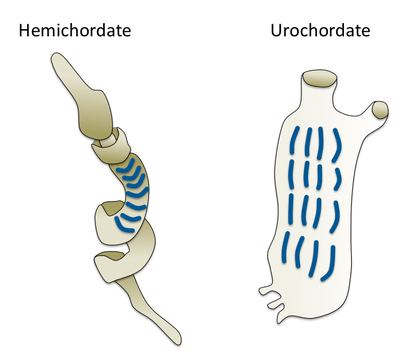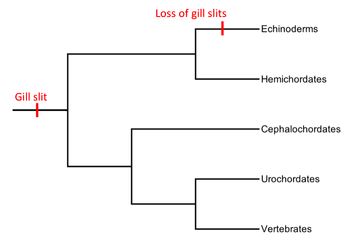Pharyngeal slit

Pharyngeal slits are filter-feeding organs found in Invertebrate chordates (lancelets and tunicates) and hemichordates living in aquatic environments. These repeated segments are controlled by similar developmental mechanisms. Some hemichordate species can have as many as 200 gill slits.[1] Pharyngeal slits resembling gill slits are transiently present during the embryonic stages of tetrapod development. The presence of gill-like slits in the neck of the developing human embryo famously led Ernst Haeckel to postulate that "ontogeny recapitulates phylogeny"; this hypothesis, while false, contains elements of truth, as explored by Stephen Jay Gould in Ontogeny and Phylogeny.[2] However, it is now accepted that it is the vertebrate pharyngeal pouches and not the neck slits that are homologous to the pharyngeal slits of invertebrate chordates. Gill slits are, at some stage of life, found in all chordates.
Pharyngeal arches in Vertebrates
In vertebrates, the pharyngeal arches are derived from all three germ layers.[3] Neural crest cells enter these arches where they contribute to craniofacial features such as bone and cartilage.[3] However, the existence of pharyngeal structures before neural crest cells evolved is indicated by the existence of neural crest-independent mechanisms of pharyngeal arch development.[4] The first, most anterior pharyngeal arch gives rise to the oral jaw. The second arch becomes the hyoid and jaw support.[3] In fish, the other posterior arches contribute to the brachial skeleton, which support the gills; in tetrapods the anterior arches develop into components of the ear, tonsils, and thymus.[5] The genetic and developmental basis of pharyngeal arch development is well characterized. It has been shown that Hox genes and other developmental genes such as dlx are important for patterning the anterior/posterior and dorsal/ventral axes of the branchial arches.[6] Some fish species have jaws in their throat, known as pharyngeal jaws, which develop using the same genetic pathways involved in oral jaw formation.[7]
Evolution of pharyngeal slits

The presence of pharyngeal slits in hemichordates led to debates of whether this structure was homologous to the slits found in chordates or a result of convergent evolution.[8] With the placement of hemichordates and echinoderms as a sister group to chordates, a new hypothesis has emerged-suggesting that pharyngeal gill slits were present in the deuterostome ancestor .[9] Intriguingly, extant echinoderms lack pharyngeal structures, but fossil records reveal that ancestral forms of echinoderms had gill-like structures.[10] Comparative developmental and genetic studies of these pharyngeal structures between hemichordates and urochordates have brought about important insights regarding the evolution of the deuterostome body plan.[11] Comparative molecular biology has revealed that the Pax1/9 genes (which encode for transcription factors) are expressed in similar patterns between hemichordates and urochordates; In vertebrates, Pax 1 and Pax 9 are expressed in the pharyngeal pouches and are important for thymus development.[12] applying excess retinoic acid (excess retincoic acid in vertebrates results in pharyngeal abnormalities) leads to the absence of gill slits in developing Amphioxus, suggesting that retinoic acid may act through the same mechanism in vertebrates and amphioxus.[13] These studies indicate that the pharyngeal slits found in hemichordates and chordates are indeed homologous in a molecular sense.
References
- ↑ Gerhart J, Lowe C, Kirschner M (2005). "Hemichordates and the origin of chordates". Current Opinion in Genetics & Development. 15 (4): 461–467. doi:10.1016/j.gde.2005.06.004. PMID 15964754.
- ↑ Gould, S.J. (1977). Ontogeny and Phylogeny. Cambridge, Massachusetts: The Belknap Press of Harvard University Press. pp. vii–viii. ISBN 0-674-63940-5.. Also ISBN 0-674-63941-3 (paperback)
- 1 2 3 Graham A (2003). "Development of the pharyngeal arches". Am J Med Genet A. 199 (3): 251–256. doi:10.1002/ajmg.a.10980. PMID 12784288.
- ↑ Graham A, Smith A (2001). "Patterning the pharyngeal arches". BioEssays. 23 (1): 54–61. doi:10.1002/1521-1878(200101)23:1<54::AID-BIES1007>3.0.CO;2-5. PMID 11135309.
- ↑ Kardong KV (2003). "Vertebrates: Comparative Anatomy, Function, Evolution". Third edition. New York (McGraw Hill).
- ↑ Depew MJ, Lufkin T, Rubenstein JL (2002). "Specification of jaw subdivisions by Dlx genes". Science. 298 (5592): 381–385. doi:10.1126/science.1075703. PMID 12193642.
- ↑ Fraser GJ, Hulsey D, Bloomquist RF, Uyesugi K, Manley NR, Streelman T (2009). Jernvall, Jukka, ed. "An Ancient Gene Network Is Co-opted for Teeth on Old and New Jaws". PLoS Biology. 7 (2): 0233–0247. doi:10.1371/journal.pbio.1000031. PMC 2637924
 . PMID 19215146.
. PMID 19215146. - ↑ Gee H (1996). "Before the backbone. Views on the origin of vertebrates". London (Chapman & hall).
- ↑ Winchell CJ, Sullivan J, Cameron CB, Swalla BJ, Mallatt J (2002). "Evaluating hypotheses of deuterostome phylogeny and chordate evolution with new LSU and SSU ribosomal DNA data". Mol Biol Evol. 19 (5): 762–776. doi:10.1093/oxfordjournals.molbev.a004134. PMID 11961109.
- ↑ Shu D, Morris SC, Zhang ZF, Liu JN, Han J, Chen L, Zhang XL, Yasui K, Li Y (2003). "A new species of yunnanozoan with implications for deuterostome evolution". Science. 299 (5611): 1380–1384. doi:10.1126/science.1079846. PMID 12610301.
- ↑ Brown FD, Prendergast A, Swalla BJ (2008). "Man is but a worm: chordate origins". Genesis. 46 (11): 605–613. doi:10.1002/dvg.20471. PMID 19003926.
- ↑ Ogasawara M, Wada H, Peters H, Satoh N (1999). "Developmental expression of Pax 1/9 genes in urochordate and hemichordate gills: insight into function and evolution of the pharyngeal epithelium". Development. 126 (11): 2539–2550. PMID 10226012.
- ↑ Holland LZ, Holland N (1996). "Expression of AmphiHox-1 and AmphiPax-1 in amphioxus embryos treated with retinoic acid: insights into evolution and patterning of the chordate nerve cord and pharynx". Development. 122 (6): 1829–1838. PMID 8674422.